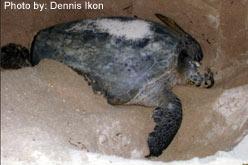|
Welcome To
TURTLE ISLAND (SELINGAN)
PAGE - SABAH
|
Continue to from PAGE 1>>
About Turtles
As the large Green Turtles as they lumber ashore, they will
select an area and dig a 12 to 18 inch deep egg chamber with
their powerful hind flippers and lays between 40 to 190 eggs,
covering them with sand before returning to sea.
Once the eggs have been laid, the eggs are removed by the
Park Staff for incubation. This is to ensure that wild
predators, such as the monitor lizards, do not get to the eggs.
A hatchery has been established on each of the three
islands. These hatcheries are situated 50 feet away from the
high water mark. In the hatchery itself, eggs are carefully
placed by hand into a pit of 30 inches deep, fenced around with
wire mesh and identified by a bamboo marker bearing with serial
number of the nest, collection date and number of eggs. These
hatchlings will then have to fend for them until they are mature
enough to mate and return back to the Turtle Islands.

An incubation period which takes between 50 and 60 days, the
young will emerge to the surface by digging their way up to the
surface of the pit. This happens usually at night, when the
sand is cooler. Usually, these hatchlings are released in the
early morning to prevent from being exposed to predators at
night while making their journey. But once in the sea, they
will be exposed to numerous dangers including being eaten by
bigger fish as well as birds. Fatalities can also occur when
they encounter plastic bags or mistake tiny hardened balls of
oil for food.
The sea turtle is a reptile, which spends all of its life in
water. Only the female turtle returns to land to lay its eggs.
All sea turtle eat marine animals such as sponges, marine worms
and mollusks except adult green turtle, which are largely
vegetarian, eating underwater grasses and seaweed. The Hawksbill
turtle is carnivorous and eats invertebrate animals of the coral
reefs. We do not know the natural longevity of the sea turtles.
They grow very slowly, taking from 10 to 20 years to reach
maturity.
Nesting
Behaviours
Turtle egg-laying is a complex process divided into eight
stages, they are:-
1. Emerging from the sea, selecting a course to a beach
2. Selecting a nesting area above the high-tide mark
3. Clearing the area with sweeping motions of the front and
enclave into the body pit. Excavating the eggs chamber with rear flippers to a
depth of about 12 to 18 inches.
5. After the completion of eggs pit, there is a interval
before they proceeds to lay eggs.
6. When all the eggs have been laid, they then proceed to cover
and conceal the nest pit. The turtle will return to sea and
whole process normally takes about an hour.

Dos and
Don’ts
Visitors
are forbidden from engaging in any of the following:
-
Wander
along the beach after dark. (Park Ranger will inform the
guides when/where there is turtle laying eggs)
-
Build
campfires, shine bright torches on the beach at night or on
the nesting turtle, as strong light will cause harm to the
turtles.
-
Disturb
the turtle during the nesting process by approaching too
close or crowding around her. Instead, visitors are advised
to watch the nesting from a distance.
-
Under no
circumstances, ride on the turtle, pull her flippers, turn
over turtle, jump on her or injure her physically. Such acts
of abuse may have adverse effects on future nesting returns.
-
Night
photography is strictly forbidden on Pulau Selingan but
allowed on the other two islands with permission from the
Park Ranger.
-
Collecting
any plant, animal or other living or non-living things is
strictly forbidden without prior written permission from the
Director of Sabah Parks. Fishing is permitted with hook and
line only.
Best time to Visit
The best time to visit this island is between March and
September, which are the driest month and the calmest sea. It
is not a good idea to visit this between October and February as
during this time the island receives the brunt of the
north-eastern monsoon gales.
Getting there
You can take a boat to Pulau Selingan from Sandakan town.
Public boat services are not available here. You need to go
through the Parks office or alternatively arrange visit through
tour operators. Permits are compulsory.
Sabah Parks
P.O. Box
10626, 88806 Kota Kinabalu
Tel:
088-211811, 212508 Fax: 088-221001, 211585
>>
Back to page 1
Turtle
Island Tour Request >>
|